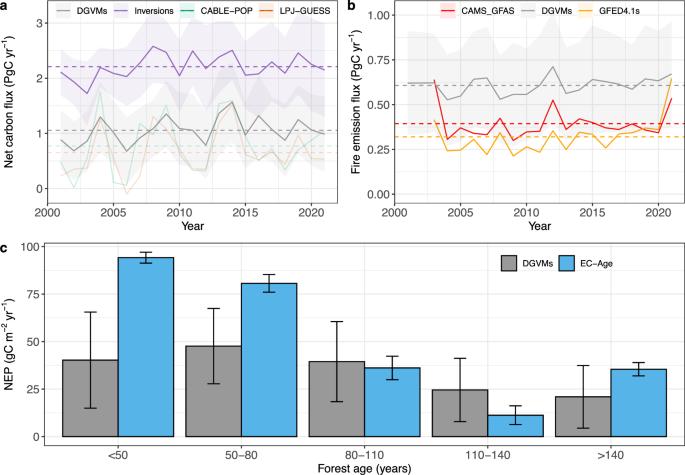The key role of forest disturbance in reconciling estimates of the northern carbon sink
IF 8.1
1区 地球科学
Q1 ENVIRONMENTAL SCIENCES
引用次数: 0
Abstract
Northern forests are an important carbon sink, but our understanding of the driving factors is limited due to discrepancies between dynamic global vegetation models (DGVMs) and atmospheric inversions. We show that DGVMs simulate a 50% lower sink (1.1 ± 0.5 PgC yr−1 over 2001–2021) across North America, Europe, Russia, and China compared to atmospheric inversions (2.2 ± 0.6 PgC yr−1). We explain why DGVMs underestimate the carbon sink by considering how they represent disturbance processes, specifically the overestimation of fire emissions, and the lack of robust forest demography resulting in lower forest regrowth rates than observed. We reconcile net sink estimates by using alternative disturbance-related fluxes. We estimate carbon uptake through forest regrowth by combining satellite-derived forest age and biomass maps. We calculate a regrowth flux of 1.1 ± 0.1 PgC yr−1, and combine this with satellite-derived estimates of fire emissions (0.4 ± 0.1 PgC yr−1), land-use change emissions from bookkeeping models (0.9 ± 0.2 PgC yr−1), and the DGVM-estimated sink from CO2 fertilisation, nitrogen deposition, and climate change (2.2 ± 0.9 PgC yr−1). The resulting ‘bottom-up’ net flux of 2.1 ± 0.9 PgC yr−1 agrees with atmospheric inversions. The reconciliation holds at regional scales, increasing confidence in our results. A satellite-based estimate of forest regrowth carbon flux across the Northern Hemisphere suggests forest disturbance and regrowth are transient but important aspects of the carbon sink that may explain underestimates from dynamic global vegetation models

森林干扰在协调北方碳汇估算中的关键作用
北方森林是一个重要的碳汇,但由于全球植被动态模型(DGVMs)与大气反演之间的差异,我们对其驱动因素的了解十分有限。我们的研究表明,与大气反演(2.2 ± 0.6 PgC yr-1)相比,DGVMs 模拟的北美、欧洲、俄罗斯和中国的碳汇(2001-2021 年为 1.1 ± 0.5 PgC yr-1)低 50%。我们解释了为什么 DGVMs 低估了碳汇,因为我们考虑到了 DGVMs 如何表示干扰过程,特别是高估了火灾排放,以及缺乏稳健的森林人口统计导致森林再生长率低于观测值。我们通过使用其他与扰动相关的通量来调节净吸收汇的估计值。我们结合卫星得出的森林年龄和生物量地图,估算了森林重新生长对碳的吸收。我们计算出的再生通量为 1.1 ± 0.1 PgC yr-1,并将其与来自卫星的火灾排放估计值(0.4 ± 0.1 PgC yr-1)、来自簿记模型的土地利用变化排放(0.9 ± 0.2 PgC yr-1)以及来自二氧化碳施肥、氮沉积和气候变化的 DGVM 估计汇(2.2 ± 0.9 PgC yr-1)相结合。由此得出的 2.1 ± 0.9 PgC yr-1 的 "自下而上 "净通量与大气反演结果一致。在区域尺度上也是如此,这增加了对我们结果的信心。基于卫星的北半球森林再生碳通量估算表明,森林扰动和再生是碳汇的瞬时但重要的方面,可以解释动态全球植被模型低估的原因。
本文章由计算机程序翻译,如有差异,请以英文原文为准。
求助全文
约1分钟内获得全文
求助全文
来源期刊

Communications Earth & Environment
Earth and Planetary Sciences-General Earth and Planetary Sciences
CiteScore
8.60
自引率
2.50%
发文量
269
审稿时长
26 weeks
期刊介绍:
Communications Earth & Environment is an open access journal from Nature Portfolio publishing high-quality research, reviews and commentary in all areas of the Earth, environmental and planetary sciences. Research papers published by the journal represent significant advances that bring new insight to a specialized area in Earth science, planetary science or environmental science.
Communications Earth & Environment has a 2-year impact factor of 7.9 (2022 Journal Citation Reports®). Articles published in the journal in 2022 were downloaded 1,412,858 times. Median time from submission to the first editorial decision is 8 days.
 求助内容:
求助内容: 应助结果提醒方式:
应助结果提醒方式:


